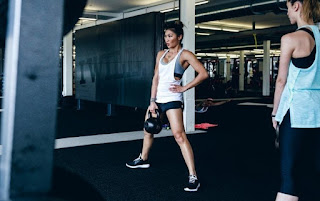Beyond learning a seemingly endless variety of exercises, equipment and machines, working out comes with its own language. You’ve got supersets, HIIT, isolations, negatives, plyometrics and dozens more terms, each with its own specific definition that, while not necessary to memorize, can really come in handy when navigating the gym.
We can add “Tabata” to that list. For the uninitiated, it’s just another word to get to know (we’ll explain in a moment), but if you’ve ever performed high-intensity intervals or attended a circuit-training class, chances are good you’re already familiar — even if you didn’t realize it.
Tabata is named for Dr. Izumi Tabata. Along with a team of researchers at the National Institute of Fitness and Sports in Tokyo, the good doctor developed a timed-interval method for exercising that alternated between 20 seconds of intense activity and 10 seconds of rest. Their research showed high-intensity intervals performed over a short duration — in this case, a mere 4 minutes — increased aerobic and anaerobic capacities more than moderate-intensity exercise performed at much longer durations.
That was back in 1996, and the study was performed on an elite group of Olympic speed skaters, so … not your average gym-goers. But the principles hold true today.
WHY TABATA WORKS
“Tabata workouts are great for increasing VO2 max and creating a great aerobic base leads to better anaerobic output,” says Dan McDonogh, Under Armour’s senior manager of athlete performance.
READ MORE: Take HIIT to a New Level With Metabolic Conditioning
By doubling the work-to-rest ratio — commonly 20 seconds of work to 10 seconds of rest — your body is forced to exercise again before it’s fully recovered. This means you’ll be repeatedly working at maximum capacity, which is something we rarely do when slogging away on the treadmill. This kind of work results in improved cardiovascular fitness and endurance.
THE PROS AND CONS OF TABATA
“Tabata workouts burn calories and improve the afterburn effect and can also improve strength and power” says McDonogh. “Plus, they save time, you don’t need any equipment, and they can be as challenging as you want.” So that’s a few big checkmarks in the pro column.
But, he adds, some people aren’t good candidates for Tabata workouts due to fitness level and injury history. Because the workouts are so intense, it’s difficult to maintain proper technique when you’re going as hard as you can. That can lead to injury. The intense nature of the workouts can also lead to overtraining or burnout.
To stay safe and avoid overdoing it, McDonogh suggests limiting Tabata-style training to twice per week, and never on back-to-back days, to allow your body to recover. He also recommends mixing in other activities like yoga, cycling and strength training. “Do a little of everything rather than a lot of one thing,” he adds.
HOW TO DO TABATAS
There’s no shortage of exercises to consider for a Tabata workout. Bodyweight moves like pushups, lunges and burpees are always popular. But so are weighted moves like kettlebell swings and squats. Put your favorite exercises into a 4-minute set of eight rounds of 20-second efforts, perform each exercise as hard as you can, and you’ll be on the right track.
To structure the workout, you can stick to the 20 seconds on and 10 seconds off format like Dr. Tabata and his team. But McDonogh reminds us Tabatas were originally designed for elite athletes with a higher-than-average capacity for aerobic and anaerobic exercise. So if you’re not quite an Olympian, consider modifying your workout.
For beginners, McDonogh likes flipping that ratio, and using a 1:2 ratio of work to rest. In this case, he suggests bumping the time up to 30 seconds on and 60 seconds off. For those at an intermediate level, he likes a 1:1 ratio of 30 seconds on and 30 seconds off. And if you’re already fit and up to the challenge, you should try to tackle the original 2:1 work-to-rest ratio.
“It doesn’t take much time to really exhaust yourself,” he says. Beginners should start with 8–12 minutes of Tabata work. Twenty minutes is a sweet spot if you’re more advanced. And I never suggest going beyond 30 minutes.”

Comments
Post a Comment